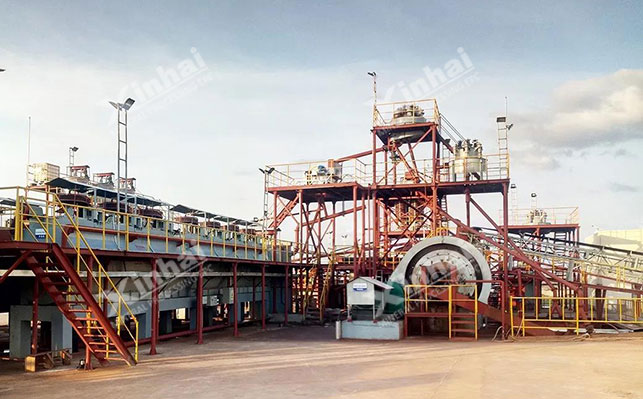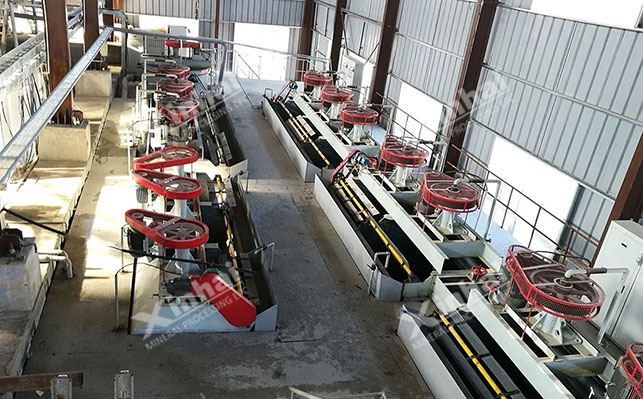Flotation is one of the main methods for beneficiation of graphite ore. The grade of graphite can reach 80-90%, even 95%, after purification. The key points of the process include flotation flowsheet and flotation reagents. In this paper, we will focus on these two aspects of graphite ore flotation.
The flotation method is mainly based on the difference in wettability between the surface of graphite and gangue minerals. Because of the good hydrophobicity of graphite, it will adhere to bubbles and float with them, while the hydrophilic gangue is left in water to achieve flotation separation. The flotation process mainly includes three parts: ore preparation, slurry mixing and grinding flotation process.

The ore preparation process of graphite can include mineral crushing, grinding, grading and other links.
Crushing: It mainly depends on mechanical force crushing through extrusion, impact, splitting and grinding to achieve the initial separation of graphite and gangue minerals. The hardness of graphite ore is generally medium hard or medium hard and soft, the grade of raw ore is between 2% and 10%, and the crushing process is relatively simple. Three stage open circuit, two stage open circuit or one stage open circuit process are often used. If it is a small mine that handles weathered ore, it can be directly grinded without crushing. Jaw crusher is often used for coarse crushing of large size minerals; Hammer crusher and impact crusher are used for medium crushing of minerals, while cone crusher and roller crusher are used for fine crushing of minerals.
Grinding: this stage is to further realize the dissociation of graphite monomer or intergrowth after crushing. In order to select large flake graphite as early as possible, multi-stage grinding process is often used in the grinding stage, and flotation is used to complete the separation. Ball mill, rod mill and stirring mill are commonly used as grinding equipment in this stage.
Grading: generally, the grinding and grading operation is composed of grinding and grinding. After grinding, the qualified particles are mixed into the classifier equipment, and the solid particles are separated according to the particle size, so that the qualified particle size products can be separated in time. Graphite grading is commonly used as grading equipment with spiral classifier.

Slurry mixing is an important process in the mineral purification and separation process, which can prepare for the subsequent separation operation. Generally, the agent is dispersed and fully contacted with the graphite mineral by adjusting the slurry concentration.
The slurry mixing operation of the graphite ore concentrator can be divided into conventional slurry mixing, aerated slurry mixing and graded slurry mixing, and then mechanical mixing, jet mixing and static mixing are carried out to complete the slurry mixing. It is mainly completed in equipment such as agitator barrel, pulp preprocessor and pulp preparator.
According to the different types of graphite, the graphite flotation process is also different. The conventional flotation process is generally a closed circuit process of multi-stage flotation middling sequential return or centralized return. When each section of grinding operation is completed, it will enter the flotation stage. For example, after the first section of grinding operation (the ore particle size reaches about - 200 mesh 40%), the first section of flotation will be carried out, followed by multi-stage grinding stripping and multiple sorting; The return of middlings refers to the process in which the middlings produced after flotation are returned in turn or collectively to the previous operation to improve the flotation efficiency of graphite ore.
The overflow ball mill is commonly used for fine grinding, roughing and scavenging, and the XJK flotation machine is used for cleaning.
In the actual beneficiation operation, in addition to the selection of suitable flotation process, the selection of reagents is also particularly important. By adding reagents, the hydrophobicity of graphite can be improved to improve the effective separation of graphite and gangue minerals. At present, the common flotation reagents for graphite ore are mainly collectors, foaming agents and regulators.
Graphite itself has a certain floatability. Graphite concentrate can also be floated without the use of collectors, but the flotation efficiency is not ideal. Therefore, a thin oil film can be formed on the surface of graphite ore by adding collectors properly to enhance its hydrophobicity and firmly attach it to bubbles, so as to improve the floatability of graphite and improve the recovery rate of concentrate. Common flotation reagents for graphite ore mainly include kerosene, diesel, liquid paraffin, heavy oil and other hydrocarbon oils.
Foaming agent is composed of polar and non-polar molecules, in which the polar group is hydrophilic and the non-polar group is hydrophobic. By adding foaming agent, the mechanical strength of bubbles can be increased, and the number, floating speed and distribution of bubbles can be controlled. Foaming agents commonly used in graphite ore include 2 # oil, 4 # oil, pine oil, cresolic acid, camphor oil, etc.
The purpose of the regulator is to adjust the role of the collector and minerals, and inhibit or strengthen the hydrophobicity of minerals. According to their different functions, they can be divided into three types: pH regulator, inhibitor and dispersant.
PH regulator: lime (CaO), NaCO3, Na (OH) 2 are commonly used;
Inhibitors: mainly sodium silicate, sodium carboxymethyl cellulose, EDTA, tartaric acid, citric acid, oxalic acid, etc;
Dispersant: mainly including sodium silicate, sodium hexametaphosphate, sodium polyacrylate, etc.
The above content is the introduction of the conventional flotation process and flotation reagents of graphite ore. In the actual concentrator, it should not be selected blindly, and should be carried out. According to the test analysis, a suitable graphite flotation process and reasonable flotation reagents should be designed to improve the beneficiation efficiency of graphite ore and obtain the desired recovery rate.